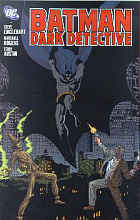 2006
- available in soft cover
2006
- available in soft cover
Batman: Dark Detective
 2006
- available in soft cover
2006
- available in soft cover
Written by Steve Englehart. Pencils by Marshall Rogers. Inks by Terry Austin
Colour: Chris Chuckry. Letters: John Workman. editor: Joey Cavalieri.
Reprinting: the six issue mini-series
144 pages
Mildly for mature readers
Published by DC Comics
Cover price: $14.99 USA
Three decades ago, Steve Englehart, Marshall Rogers, and Terry Austin produced a brief run of Batman stories in Detective Comics that was considered a creative benchmark, with fans long after demanding (in vain) the return of the love interest Englehart introduced in those issues, Silver St.Cloud. It's one of the few Bronze Age (late 1960s to mid-1980s) story arcs DC has collected in TPB form -- as Batman: Strange Apparitions. (I actually came across a review which, referring to that Englehart/Rogers run, claimed it was what the 1989 Batman movie was based on -- sure, insofar as they both featured a guy with pointy ears and a cape...but not in anyway that related to plot, theme, characterization, style, or artistic intent. I've seen that before -- it's a trendy marketing ploy when a super hero movie/TV show does well, to hype any and all comic book stories as being THE one that directly inspired the movie, even if it bears little resemblance to it).
Anyway, last year the team reunited (including letterer John Workman) for the mini-series, Batman: The Dark Detective, subsequently collected in a TPB.
For the record...I wasn't a big fan of the original Englehart-Rogers run. But I picked this up, unhappy with some current Batman stories and feeling nostalgic. What I got...was one of the best mainstream comics in recent years!
Englehart sets it up as unpretentious, super hero adventure, with The Joker, Two-Face and the Scarecrow all in town, pursuing separate schemes...but then he returns Silver St. Cloud. She rekindles her romance with Bats, and the comic takes on a refreshing maturity, as we get a grown up, and messy, relationship (Silver is engaged to another man, a gubernatorial candidate the Joker is targetting). Englehart, while still portraying a brooding Batman, redefines him as a three dimensional human being, capable of passion, insecurity, and even wit.
There's humour, too, and Englehart throws in cheeky political jibes -- adding to the sense he's writing up to his readers, not down. Current affairs satire in a super hero comic? Will wonders never cease? There's also a Cary Grant reference and character names derived for old Batman writers and artists -- again, suggesting an older target audience.
Rogers-Austin's line work isn't as tight as in their heyday, but Rogers can do mood-heavy backgrounds like few others, and flares Batman's cape with a aplomb. He often had a good eye for composition but perhaps because of the character-rich scenes, excels himself here. And the fight scenes, though innovative, retain a pleasing reality.
The adventure aspect is straightforward, super heroics -- The Scarecrow doesn't even seem to have any particular plan. Though Englehart has a better sense for making the Joker seem truly crazy than most writers. But by having three villains, we get a cleverly chaotic reality, where Batman can't just deal with one case at a time (as he remarks to Two-Face when stumbling upon the latter during a robbery: "I was actually looking for the Scarecrow!") While a scene where Joker and Two-Face briefly confront each other is an understated bit of coiled tension, suggesting two old soldiers but with significantly different world views -- none of the cutesy "super villain club house" stuff ala Identity Crisis.
But it's with the characterization that the saga leaps above the crowd. Englehart puts a provocative spin on Two-Face's two-headed coin obsession that, if other writers had already posited it, I've never read. However, it's with Batman that Englehart really shines, creating a plausible human being, not just an icon. In fact, the reason the Scarecrow doesn't seem to have much of a goal is because he's really just a catalyst for exploring Batman's psyche.
Of course Silver and Bats don't live "happily ever after" -- though not necessarily for the reasons you might expect.
Admittedly, the climax left me with mixed feelings as Batman, and some police, separately invade the Joker's booby trapped house. It's a genuinely creepy, edge-of-the-seat sequence -- generating more tension than I expected, or thought could be mustered in a comic book form (especially given that Bat-foes with booby trapped lairs are a hackneyed staple of the character). But it demonstrates a level of violence that jars with the series overall.
There are some continuity questions. Batman is an outlaw, but it's not explained why, and Englehart ignores that Silver had previously returned to Gotham (in the "Siege" storyline, from the comic Batman: Legends of the Dark Knight -- drawn by Rogers, yet!). Silver's participation in that earlier story was sufficiently peripheral that he could've told this story while still acknowledging it.
Anyway...
What was maybe intended as just an excercise in nostalgia turns out to be a refreshing mix of fun, four-colour super heroics...and sophisticated, adult drama. What Batman should be...and too rarely is. Definitely recommended.
Reviewed by D.K. Latta
Got a response? Email us
at lattabros@yahoo.com